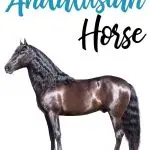The power and grace of the Andalusian horse breed can be traced back to the ancient Greeks, Romans, and Iberian royalty. Like the Lusitano, the Andalusian horse hails from the Iberian peninsula of Spain. These elegant horses are popular in dressage rings, and their gentle temperaments make these classic horses a solid choice for any pleasure rider.
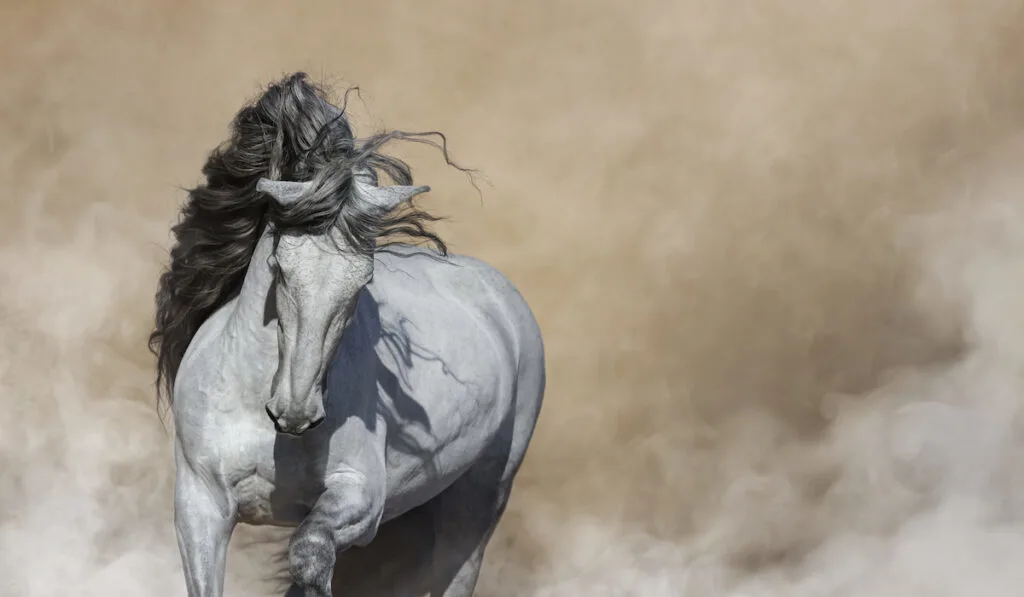
Table of Contents
Origins
Andalusians are an ancient breed. Often referred to as pure Spanish horses, P.R.E, or Pura Raza Espanola, these noble steeds were originally bred for military service, bullfighting, and general riding. They are named for Andalusia, a southern region of Spain.
The origins of the Andalusian date back to the Roman empire – evidence of similar early Iberian horses exists on artifacts from that period. However, the modern Andalusian more closely resembles the horses born in the middle ages.
In medieval times, equestrians referred to horses by type, rather than by breed. Andalusian predecessors were small medieval warhorses called “Jennets”. Jennets were well-muscled, easy-going, and had a smooth ambling gait – not unlike today’s modern Andalusian.
In the 8th century, Moors from North Africa invaded the Iberian peninsula and brought their Barb horses with them. DNA testing of modern horses indicates that Andalusian bloodlines trace back to the Barb as the groups intermingled. (source).
These fiery desert racehorses were athletic, had excellent stamina, and influenced the Andalusian and many other breeds throughout the world.
Global impact
As Spanish conquistadors traveled to the Americas in the 16th century, they brought their Andalusians across the great sea to conquer the new world. The cultural impact from the arrival of these horses was huge – life in the Americas was never the same.
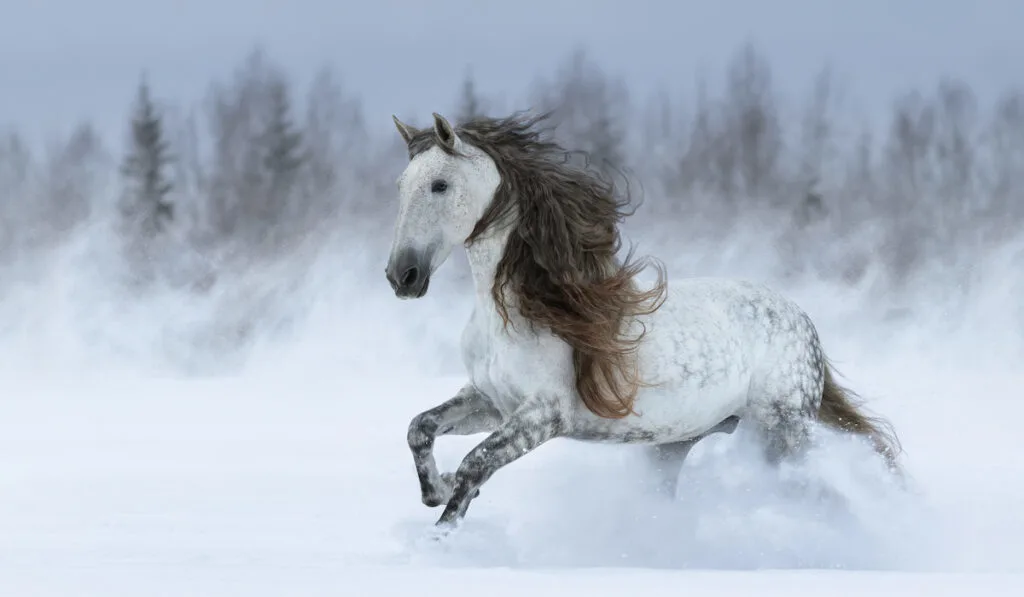
Indigenous people of the Americas learned to use horses to their advantage, and European settlers further refined imported horses from their home countries with classic Spanish stock to produce horses uniquely suited for life in the Americas.
While modern American horses look quite different from their distant Andalusian cousins, the influence of these Spanish horses was integral to the global effect of horses as a whole.
Eventually, Andalusians became the “horse of kings,” and were often given as gifts amongst the nobility. Spanish diplomats used these horses as gestures of good faith in diplomatic endeavors.
For hundreds of years, the spirit of the Andalusian has remained similar to what it was in its earliest days– the result was a hard-working, willing, athletic horse suitable for many disciplines.
Carthusian monks and the Cartujano subtype
Much of the longevity of the Andalusian is thanks to Carthusian monks. Tasked with keeping bloodlines pure, Carthusian monks kept meticulous breeding records – an important foundation for any studbook.
Carthusian Andalusians are a sub-type of the breed, and are nearly all of them are descendants of a legendary horse called Esclavo. This horse had warts under his tail, a trait which he passed to his offspring – horses without warts had their parentage called into question.
The monks refused to introduce Neopolitan and European bloodlines into their herds, which sometimes directly contradicted royal orders.
During the Peninsular Wars in the early 1800s, the monks were forced to leave their monastery. The breed almost became extinct, but the Zapata family purchased 3 stallions and 60 mares and hid them away – keeping the breed alive.
Today, less than 3% of Andalusians have Carthusian blood, but they are still said to be some of the purest and most precious examples of the breed.
While there is technically no genetic distinction between Carthusian and non-Carthusian Andalusians, they tend to exhibit a few traits that make them unique. Carthusian Andalusians may often sport a bay coat, rather than gray, and their heads may be slightly more concave.
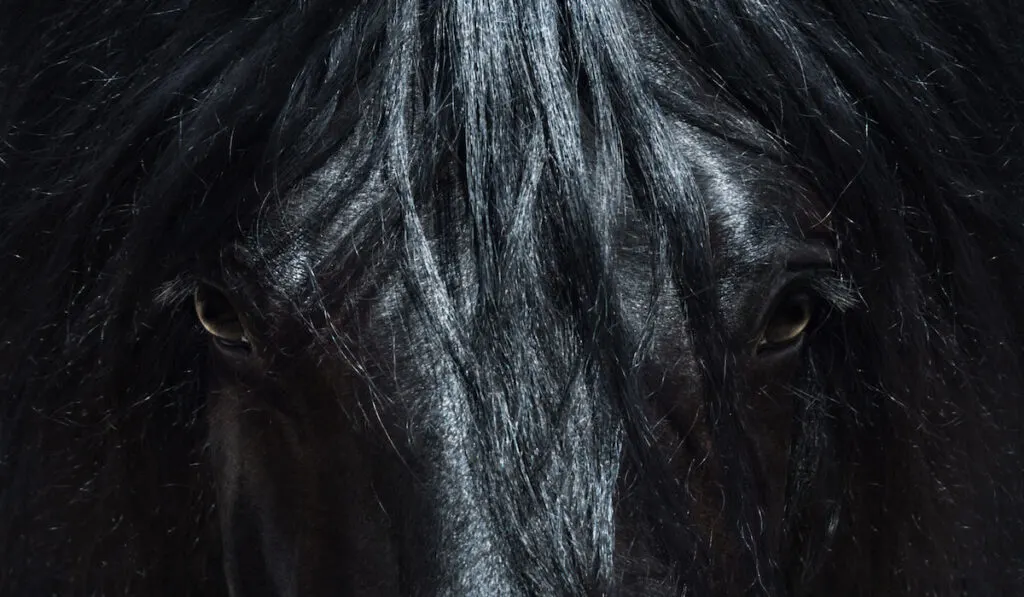
Conformation of the Andalusian Horse
Andalusians are well known throughout the world for their elegant good looks and floaty way of moving. They are generally considered “warmblooded” in nature – heavy enough to carry riders into battle and athletic enough for any discipline, but still fairly light-bodied and agile.
Horses of this type would also include the Friesian, European warmbloods, or other middle-weight horses that aren’t draft or racing breeds.
Andalusians with proper confirmation tend to have the following traits, although official requirements may vary depending on country and registry:
- Balanced conformation – no harsh angles or awkwardness.
- Elastic movements, with considerable elevation and extension of the limbs.
- Intelligent, with a willing disposition, making them suitable for many disciplines.
- Thick and silky mane and tail
- Straight or slightly convex profile, in the classic Spanish horse style
- Thicker, arched neck
- Strong, hindquarters with low-set hips, a lower set tail and nicely rounded croup.
Horses with significant conformation faults may struggle with classical dressage, which is the discipline for which they are most strongly suited, and for which they were originally bred. But, their gentle and willing temperaments allow them to excel in a variety of equestrian activities – driving, jumping, rodeos, parades, or casual pleasure riding.
These solidly built horses generally stand between 14.3 hands and 16.2 hands high (averaging around 15 hands high), and they generally weigh around 1100 pounds. Their slightly heavier build allows them to carry heavier weights, just as they did in medieval times.
Andalusian Horse Colors
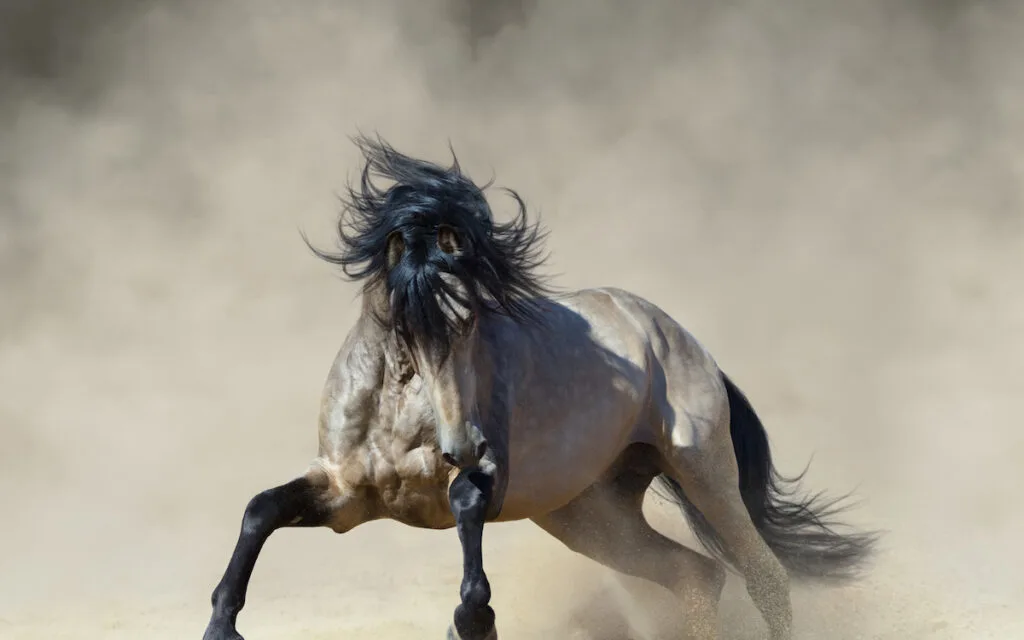
Andalusians may generally appear in any solid color (such as brown, bay, chestnut, cremello, etc), but most are gray or bay. Pinto and Appaloosa coat patterns are not allowed in the registry.
A pure black Andalusian is often highly coveted by those who dream of owning their very own “Black Beauty”.
According to the IALHA, acceptable colors for purebred Andalusians are:
- Grey
- Bay
- Black
- Black Bay
- Chestnut
- Buckskin
- Dun
- Palomino
- Cremello
- Perlino
The registry does allow other rare colors to be considered for horses who have been parentage verified. (source)
Andalusian Crosses and Partbreds
Crossing Andalusians with other breeds is a common practice that results in highly versatile animals suitable for many disciplines. Andalusians weren’t exported to the US until 1962, so getting your hands on a purebred was difficult.
Partbred Andalusians may be registered with the Association of the Foundation Andalusian Horse registry or the Australasia Andalusian Association.
Common crosses include Friesians, Thoroughbreds, Arabians, and Quarter Horses. The largest Andalusian registry (The International Andalusian and Lusitano Horse Association) also registers purebred Lusitanos, as well.
Difference between the Lusitano and Andalusian
In the early development of the two breeds, there was little difference between the Lusitano and the Andalusian – except the country of origin. Andalusians were from Spain, and Lusitanos were from Portugal.
Eventually, a modern horse breed appeared in the mix – the Azteca, native to Mexico. These three breeds are genetically very similar (the Azteca is the result of crossing the Andalusian with American quarter horses).
In the 17th century, breeders began refining Lusitanos and Andalusians for different purposes – Andalusians became mounts for nobility, and Lusitanos continued to be bred for bullfighting.
Both horses share the same muscular, compact bodies and slightly convex roman noses of their ancient Iberian cousins. However, Lusitanos are said to be more “fiery”, have stronger and more explosive hindquarters, tend to stand a little taller and come in more colors than the typical gray or bay Andalusian. (source)
Both breeds are fine examples of the ancient, strong, and powerful breed coming out of the Iberian peninsula.
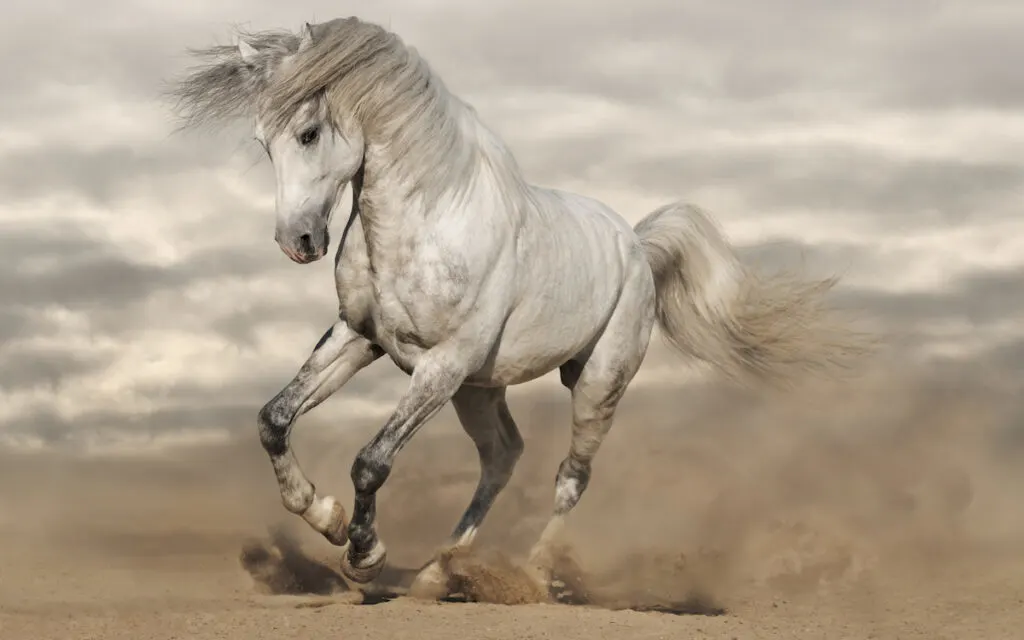
Influence on other breeds
As Roman influence spread around the world, their horses had a profound influence on the development of several modern breeds. Once the Andalusian was further refined from those ancient Iberian horses, they continued to influence other breeds into the horses that we have today.
- Lipizzaners. In the 16th century, Emperor Maximillian II of Hamburg introduced the Andalusian to Austria. He and his brother, Archduke Charles II, began a noble breeding program that eventually produced the high-flying white Lipizzaners of the famous Spanish Riding School in Vienna.
- Azteca. A modern breed from Mexico, the Azteca is a cross between the Andalusian, the Quarter Horse, and the Mexican Criollo. In the US, they may be crossed with American Paint Horses to produce a wide variety of flashy colored horses.
- Warlander. These horses are produced by crossing Friesians with purebred Iberian horses, such as Andalusians and Lusitanos. While breeders have been crossing these horses for hundreds of years, the Warlander has only been recognized as an organized breed since the 1990s. (source)
- European warmbloods. Some equine researchers argue that the Andalusian influenced the North African Barb horse, which is a direct influence to several modern sport horse breeds such as the Trakhener, Hanoverian, and even the Thoroughbred. Evidence suggests that the Barb and the Andalusian influenced each other, as many different groups of people occupied the Iberian peninsula during that time. However, considering that both the Andalusian and the Barb are ancient, well-refined breeds, there’s little doubt that many of the positive attributes of modern warmbloods may have come from either of these fine specimens. (source)
Most Common Uses for Andalusian Horses
Andalusians are known for their versatility. They are suited for most disciplines, and their gentle temperaments make them appropriate to carry riders of many levels.
A complete beginner with no plans of showing may not want to invest in a purebred Andalusian, only because there are plenty of horses that would be suited for that purpose at a lower price point.
But if you may want to show in the future, an Andalusian could suit your needs for a variety of pleasure classes – or high-level competitions.
Dressage
Andalusians are well known for their talents in classical dressage. This breed is generally quiet, well-mannered, and learns quickly. Their movements are energetic and fluid, and their bodies are compact and well-muscled.
Dressage developed as a method to train for war. Andalusian horses were originally bred for battle – a medieval knight and all his gear is a heavy load, but his a good warhorse must be sprightly and flexible.
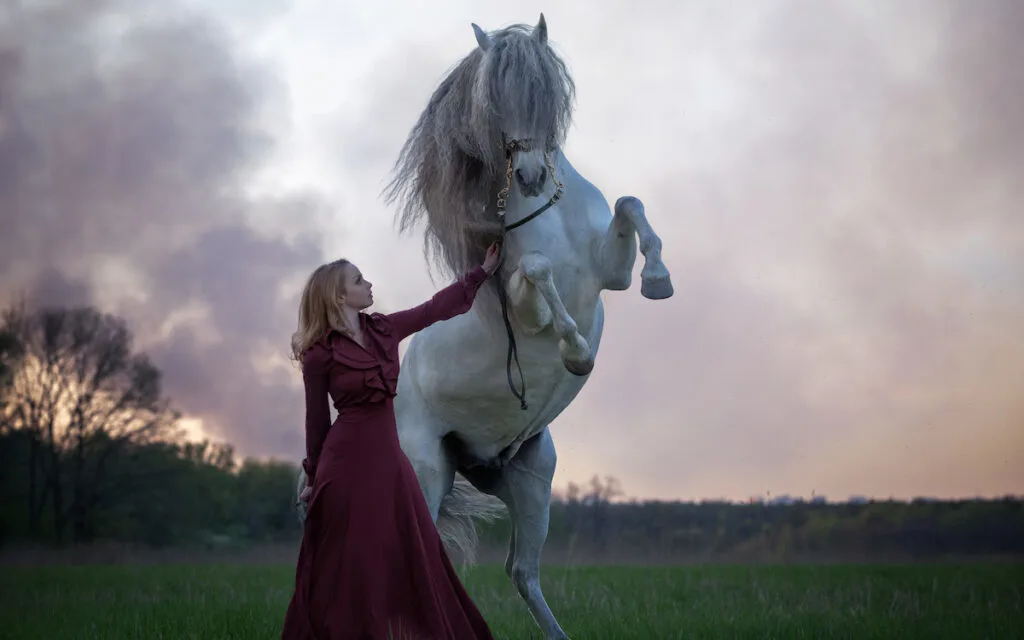
The Andalusian warhorse must be agile and responsive, be able to turn at a moment’s notice, and must perform complex movements with just a subtle flick of the reins. These horses also needed to have good collection through the hindquarters and back – good propulsion upward, rather than straight forward.
Andalusians are also designed to be comfortable to ride – a jerky dressage horse would be no good at all! The conformation of a modern Andalusian and his famous good-temperament means that he is an excellent choice for the dressage ring.
Bullfighting
Fighting a bull to the death is a traditional sport on the Iberian peninsula. Horses must be well trained, agile, and strong if they are to be ridden by a picador into a bullfighting ring.
These horses are often injured by the bull – in the 1930s, they began wearing a protective padded covering called a peto.
Bullfighting is an ancient cultural tradition. While it is illegal in most countries due to concerns for animal welfare, you can still find Andalusians in bullfighting rings today (mostly in Spain, Portugal, and some areas of Latin America).
The Lusitano is more suited for bullfighting. Spain and Portugal had different attitudes towards bullfighting styles and the use of horses.
Once horses became less popular in the bullfighting rings in Spain, the Andalusian and the Lusitano deviated into two separate breeds (although they are still very morphologically similar).
Special Performances
Andalusians are also exceptionally popular in costume classes where they can show off their uniquely good looks. Andalusians and Lusitanos sport long, luxurious manes and tales that catch the eye of spectators during parades. They’re also popular in trick training, special performances, and rodeos.
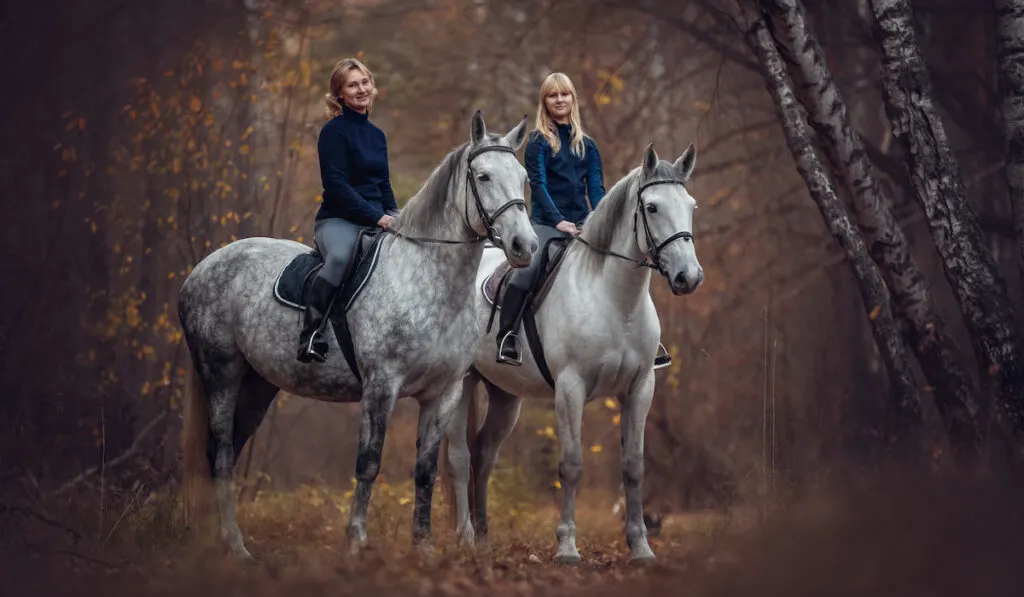
The Cobra
Andalusians are often shown in-hand, whether during a Spanish Horse show, exhibition, or other events. However, one specific event is based on the ancient practice of using these horses to thresh grain.
A group of mares shown in hand by a single handler is called a cobra. Between three and five (and sometimes 20 or more!)
Andalusian mares are linked together using a long rope and neck collars. These mares must be obedient, focused, and respond well to voice commands.
Exhibiting mares in a cobra is a good way to show off the success of a particular breeding program. Mares are judged on their conformation, their obedience, and their stock horse uniformity (they receive higher marks if they’re similar in color, size, type). (source)
Other uses
Because Andalusian horses are so versatile, they can be used for almost anything. They may not be the fastest horses around a jumping course, but because Andalusians are usually willing – there’s no reason why they couldn’t be trained to jump (with proper conformation).
Andalusians are also popular in saddleseat competitions, due to their high knee action and flashy way of moving.
They’re also well suited for pleasure classes due to their easy-going natures. Some people also choose to drive their Andalusians as well.
Whether you ride Western or English, competitively or casually – an Andalusian is usually a good choice for any discipline.
Famous Andalusians
Because of their teachable personalities and stunning good looks, Andalusians are popular choices for use on the screens. They are especially common in fantasy epics or medieval battle scenes. Here are some famous Andalusians on and off the screen:
- Traveler. The current mascot for the University of Southern California football team is a Trojan rider aboard a valiant white Andalusian, Traveler. Previous iterations of Traveler were played by Tennessee Walking Horses, Arabians, and other breeds.
- Florian. Ridden by Arwen in the Lord of the Rings trilogy, Florian played the part of Asfaloth. Viggo Mortensen actually purchased Florian for Jane, Liv Tyler’s stunt double.
- Demero and Blanco. This pair of Andalusian stallions played the regal part of Shadowfax, Gandalf’s horse in the LOTR trilogy. (source)
- Jabonero. Russell Crowe rode an Andalusian during the climactic final scene of the movie Gladiator. Jabonero also carried Sir Galahad in King Arthur, played by Hugh Dancy.
Most of the knights of the round table in the 2004 version of King Arthur rode Andalusian horse actors, which used nearly sixty horses for the film. (source)
Health
Andalusians are relatively healthy horses, thanks to hundreds of years of careful breeding. They live about as long as other horse breeds (between 25-30 years) although of course, some may live even longer!
Despite their general good health, sound feet, and easy keeping, they may suffer from a few diseases at higher rates than other horses.
- Ischaemic diseases of the small intestine
- Inguinal hernias in stallions
- Laminitis or other complications from intestinal issues.
However, they also seem to have lower incidents of large intestinal obstructions. Overall, Andalusians are healthy, strong, and can live long and healthy lives with their human partners.
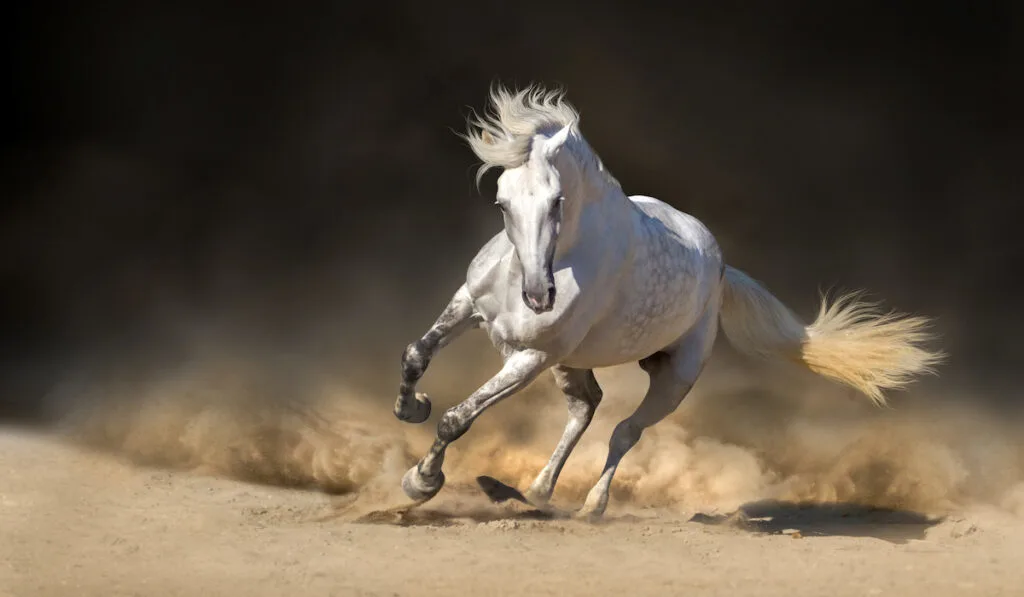
Cost
If you’ve been eyeing an Andalusian of your very own, be aware that this breed can vary wildly in price. Depending on what country you’re in, there may be a plethora of solidly bred Andalusians to choose from.
If they are uncommon and cost-prohibitive in your country, you might want to consider a half-Andalusian part-bred instead.
Depending on the discipline you seek, a well-bred and highly trained Andalusian could cost anywhere from $20,000 to $50,000. Younger, untrained animals can still fetch between $10,000 – $20,000 depending on bloodlines.
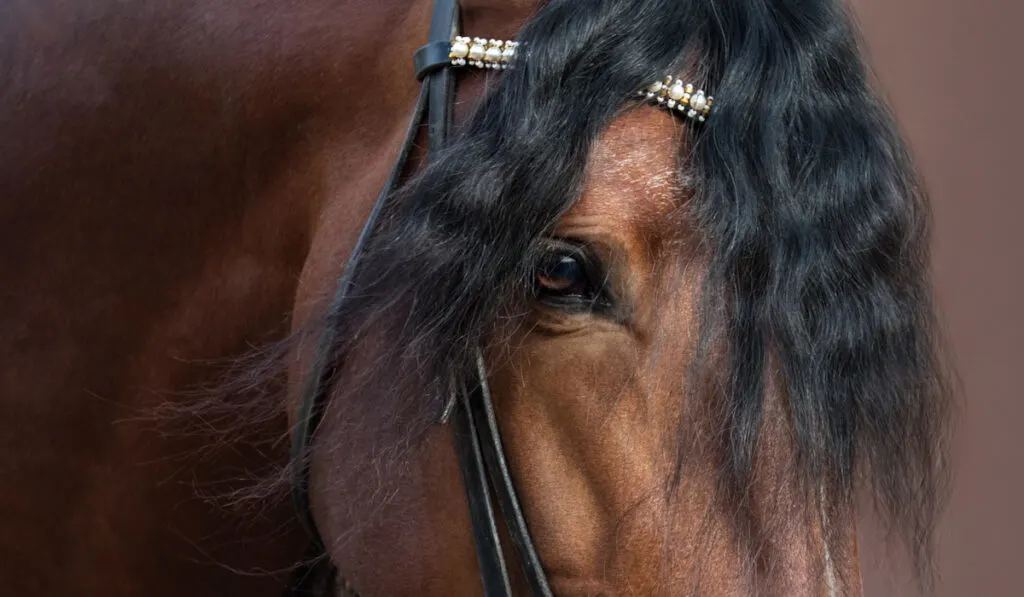
Is an Andalusian right for you?
The Andalusian is a graceful, elegant, and ancient breed. If you’re looking for a classic Spanish horse with good looks and a fantastic temperament, an Andalusian is a solid choice. These horses make excellent companions for any discipline you choose, and they’ll be sure to turn heads wherever they go.
Other sources:
- http://imh.org/exhibits/online/breeds-of-the-world/europe/andalusian/
- https://academic.oup.com/jhered/article/96/6/663/2187610
- https://ialha.org/what-the-ialha-registry-is/
- https://www.horsebreedspictures.com/carthusian-horse.asp
- http://afs.okstate.edu/breeds/horses/andalusian/index.html/
- https://traditionalcatholicism83.blogspot.com/2018/01/the-carthusian-horse.html
- https://andalusitano.com/andalusian-versus-warmblood-dressage-horse/

